All About PPC Cement | What Is PPC Cement | Types of Pozzolana Materials | Manufacture of Portland Pozzolana Cement | Uses of Portland Pozzolana Cement
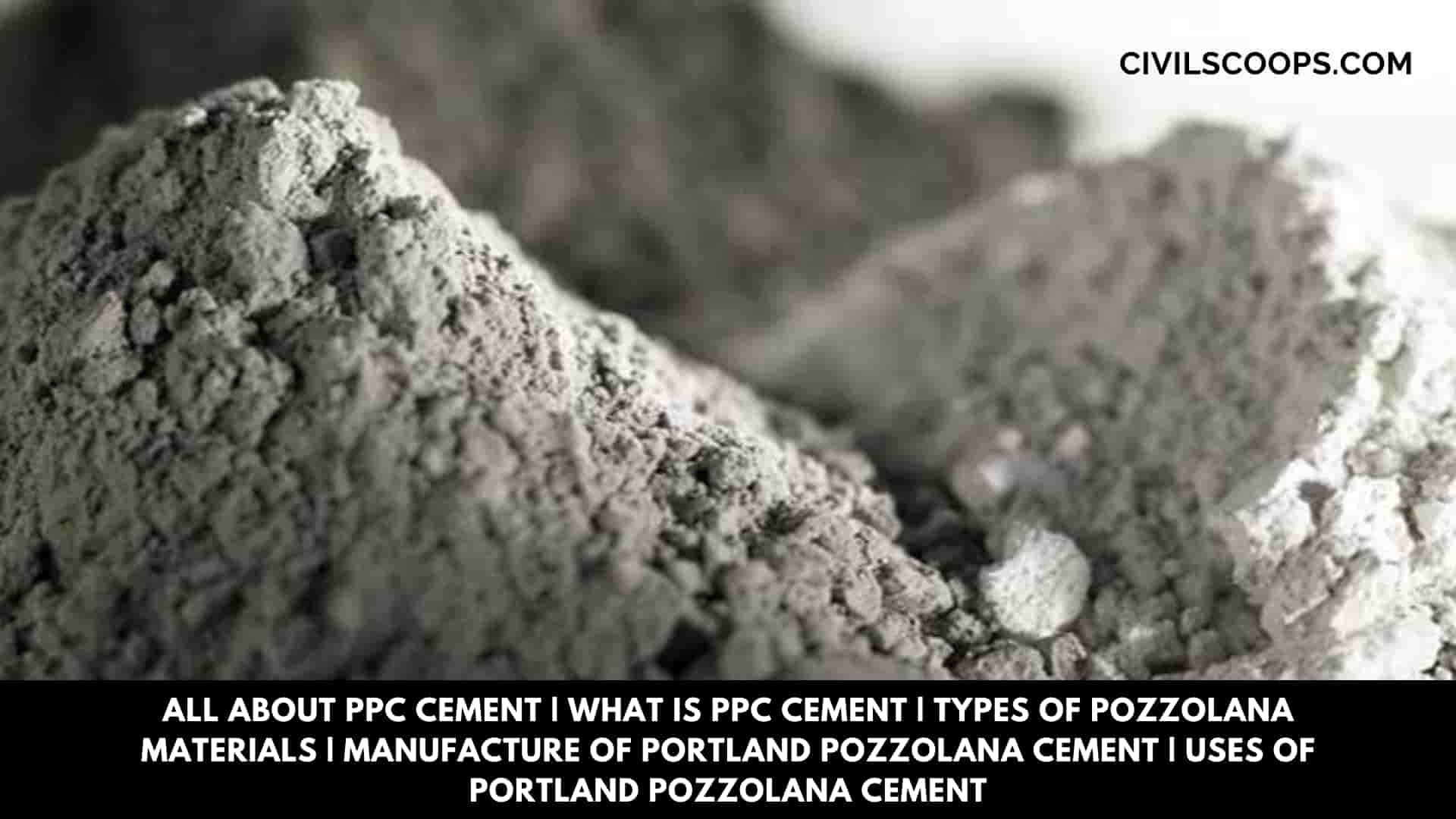
Table of Contents
What Is PPC Cement?
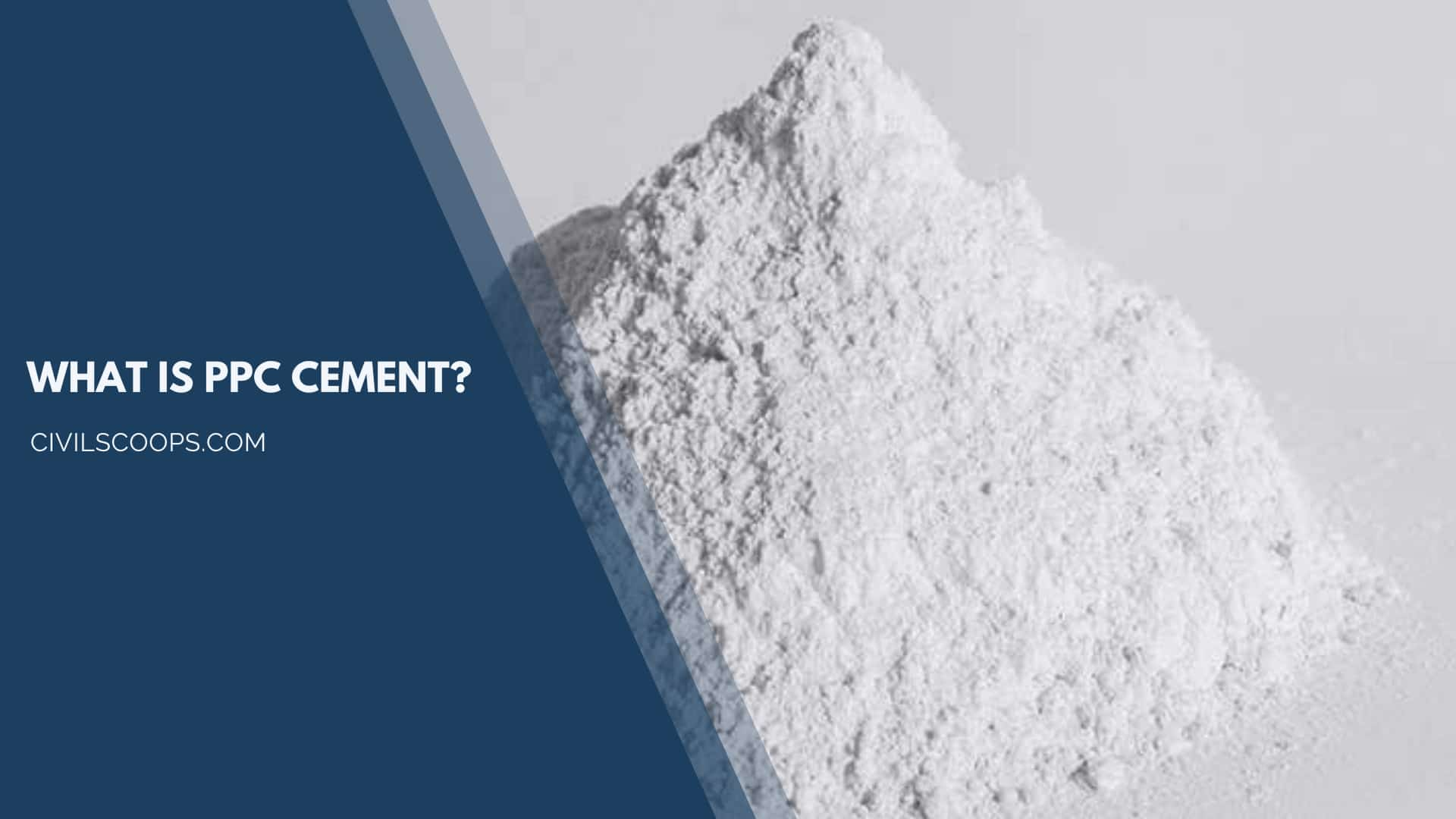
Portland Pozzolana cement is an incorporated cement produced in that certain ratio by the synthesis and characterization of OPC cement from pozzolana materials. It’s also generally referred to as PPC cement.
PPC type cement is a form of Portland cement distinguished by the existence of pozzolana particles such as fly powder, volcanic ash, that is applied to OPC by 15 percent to 35%. Cement is accessible in every grade. It is indeed finer and far less dense than the OPC.
The inclusion of pozzolana particles contributes to the production of cement, which uses less OPC but has greater longevity and strength. PPC grade cement does have a greater settling period as well as a lower compressive strength initially. Even so, the very same outcomes as OPC are considered to be obtained in the long term.
It is usually used for the building of marine systems, masonry mortars including hydraulic structures. These are widely found in mass concrete works such as dikes, sewer tanks, and dams, respectively. In certain instances, PPC cement grade must be used in replacement of OPC.
Types of Pozzolana Materials
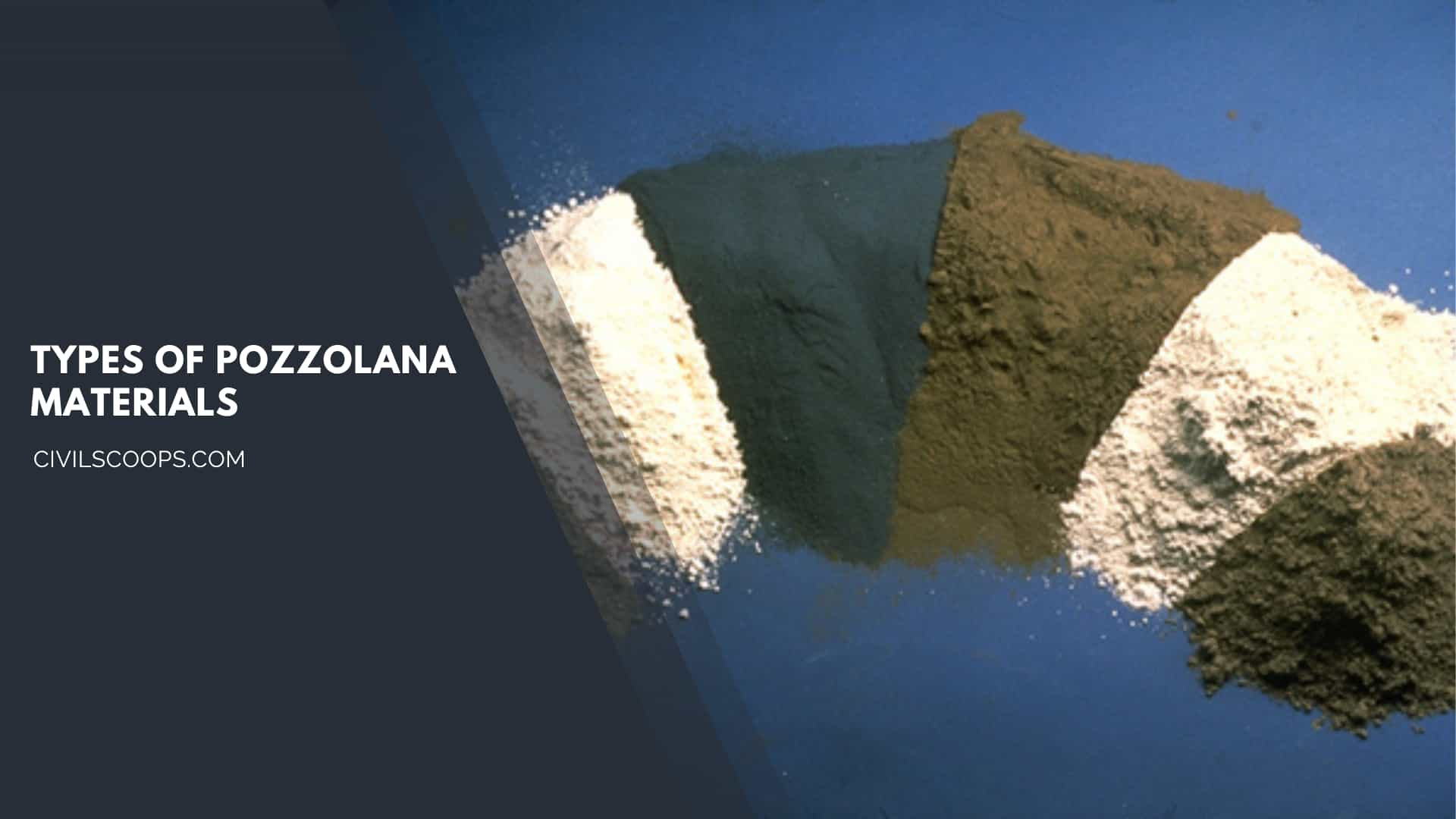
Pozzolanic materials are siliceous as well as aluminous materials, having very little if any cementitious quality of their own, but also in finely separated form and even in the presence of water, respond chemically with calcium hydroxide produced at normal temperature by hydration process to form compounds possessing cementitious properties.
Siliceous or aluminum compounds in a finely separated shape react with calcium hydroxide in order to form extremely stable, cemented substances of a diverse structure containing calcium, silica, and water.
Usually, amorphous silicate reacts even quicker than that of the crystalline form. Calcium hydroxide, a water-soluble substance, is transformed through an insoluble cement either by process of pozzolanic materials.
Originally, the pozzolanic reaction occurs and therefore the processing of hydration heat as well as the formation of power is also slow. The reaction requires the absorption of Ca(OH)2 and therefore there is no output of Ca(OH)2. The reduction in Ca(OH)2 improves the toughness of cement paste by making cement paste thick and impervious.
Also Read: OPC vs PPC | Difference between OPC and PPC Cement
Pozzolanic materials might be of two groups:
1. Natural Pozzolanic Materials
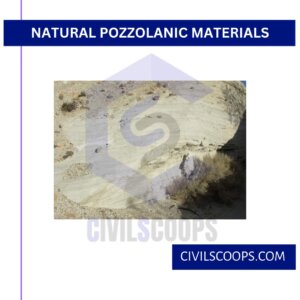
Natural pozzolan is a raw or calcined natural material that shows pozzolanic properties. Volcanic ash or pumicite, tuffs, shales, and opaline cherts and diatomaceous earth are examples of natural pozzolans.
- Calcined diatomaceous earth.
- Volcanic ash, Tuffs, and Pumicites.
- Opaline cherts.
- Clay and shales.
Natural pozzolans should be more grounded and calcined to enable them. Theses days, these also losing attention owing to the accessibility of more successful artificial pozzolans.
2. Artificial Pozzolans
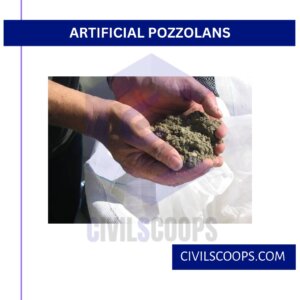
Silica Fume: That is an artificial pozzolanic product. It’s also created by the reduction of high-quality quartz using coal inside an electric arc furnace in the manufacturing of silicon or ferrosilicon alloys. Silica smoke rises as oxidized gas in the method. It melts, compresses, and gathers in fabric bags. The silica smoke so obtained has been further treated to extract impurities and also to monitor the size of the particles.
Fly ash: This is a finely separated residue from its burning of powdered coal. This is a waste material of coal-fired power plants and railway locomotives, respectively. It was the most popular artificial pozzolana material. Fly ash crystals are spherical being of the same fineness as cement. Silica is also still easily accessible for a reaction.
Pozzolanic activity of fly ash is pleasant, although it is important that this has a steady carbon content as well as a constant fineness. Its use of fly ash in concrete as a blend not just to adds technological benefit to the properties of concrete, but also leads to the prevention of environmental emissions.
Blast furnace slag: The replacement of cement with ground granulated blast furnace slag has been found to diminish the measure of water in the new concrete to acquire a similar droop. The decrease in water substance will be more with the increment of slag substance and fineness of the slag.
This is because of the various designs and state of slag and cement particles. Further the water added for blending isn’t promptly lost because of the slight lower surface hydration of slag than cement.
Manufacture of Portland Pozzolana Cement
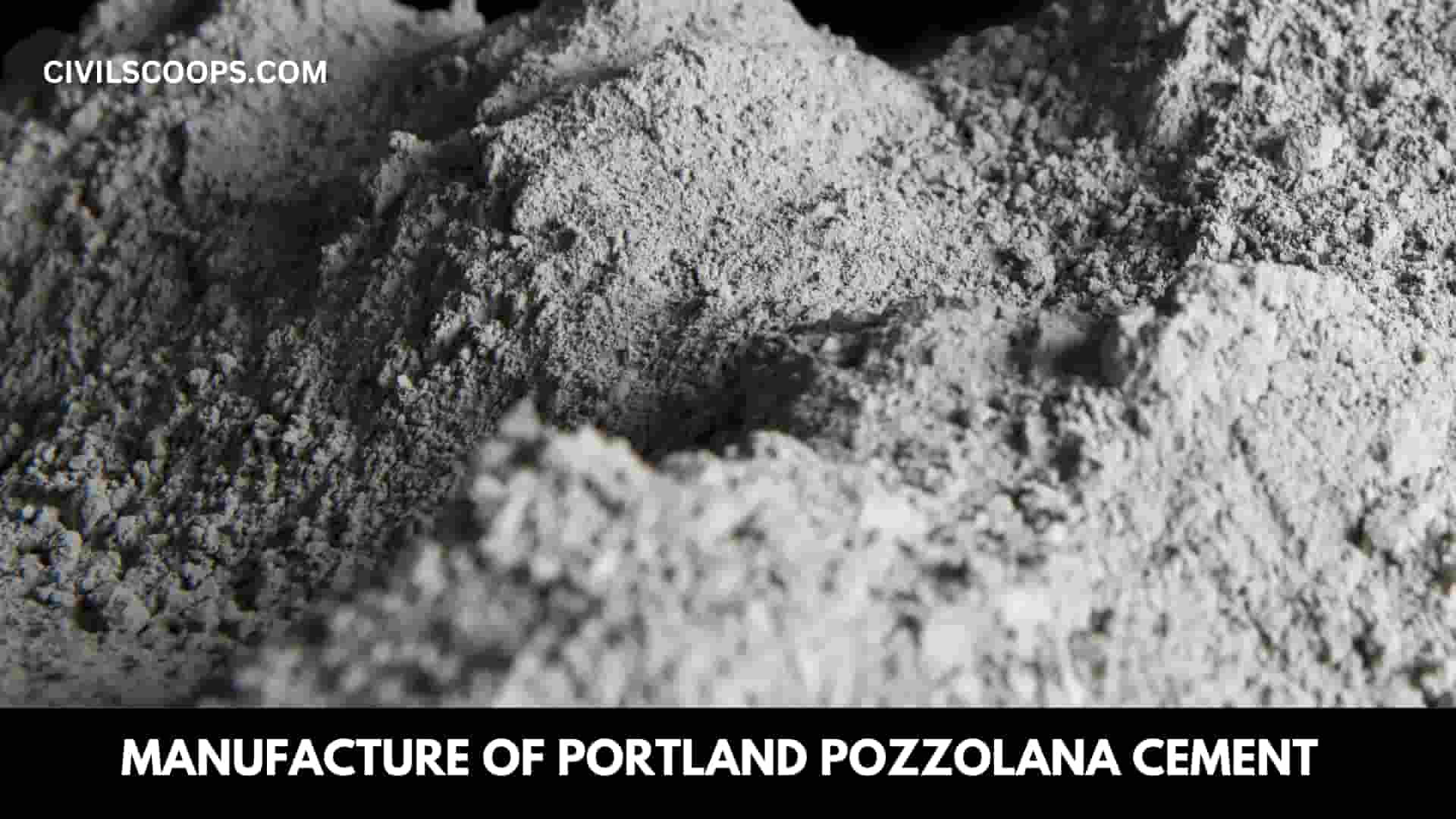
Portland Pozzolana Cement is made by mixing and grinding Portland Cement Clinker, Pozzolanic Materials, and Gypsum.
The production process is roughly the same as ordinary Portland cement, which can be separated into four processes: crushing of raw materials, grinding of raw materials, calcination of clinkers, and grinding of cement.
- Crushing of Raw Material: Limestone and clay are the primary ingredients used in the manufacture of Portland cement. After digging, these raw material stones are dumped by trucks and sent to crushers to reduce the particle size. They are then piled up in a pre-homogenization yard waiting to be recycled.
- Raw Material Grinding: The fine particle size raw materials are fed to the raw mill in the desired proportion for further reduction of the particle size, then deposited in silos, and the process of mixing and homogenization of the material is completed.
- Calcination of Clinker: Cement raw food is sent to a cement rotary oven to be calcined at a high temperature. After many chemical reactions, some spherical grey particles, which we call clinker, are produced. These hot clinkers can be cooled to a regular temperature in the cement cooler.
- Cement Grinding: Upon freezing, the clinker is combined in an adequate amount with pozzolanic materials as well as gypsum before being sent to the cement mill for actual grinding. Cement material is normally processed in cement silos and packaged as well as processed in the factory.
Properties of Portland Pozzolana Cement
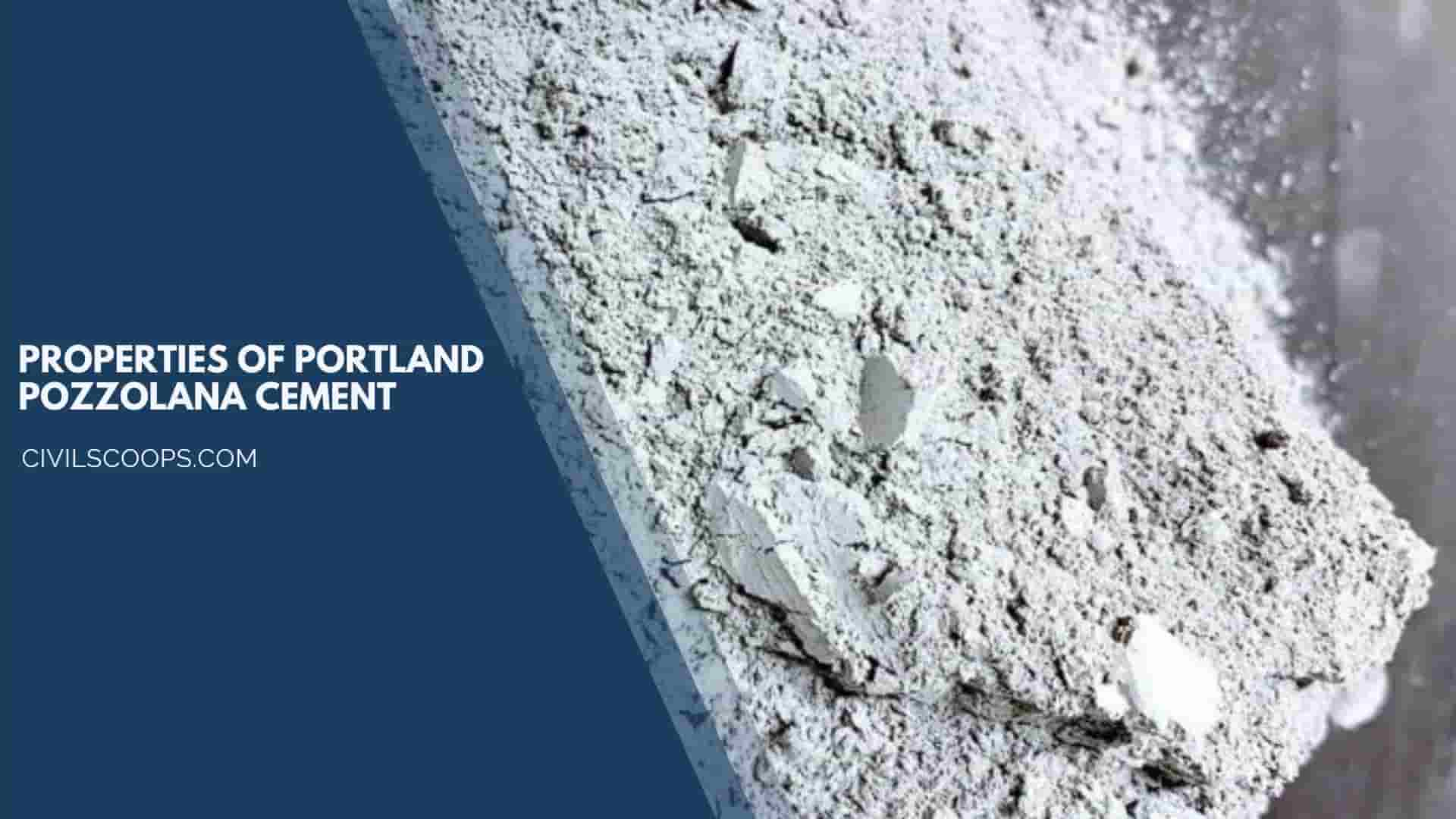
- PPC cement has to be cured for a lot longer, as well as the curing temperature does have a major impact on the development of its strength. Whenever the temperature is low, the hardening process is sluggish. Although steam curing or humid heat treatment is being used, the hardening is intensified so that the cement isn’t really ideal for winter building.
- The initial strength of the PPC cement is smaller, however the final strength is high. That’s also owing to the effective silica in the pozzolanic substance reacting with the calcium hydroxide in order to create a significant volume of hydrated calcium silicate.
- The water demand for PPC cement is strong since the mixture content is porous and the fine particles are fine. The water demand of normal consistency differs with the form and quantity of the mixture.
- Portland pozzolana cement has a reasonably long fixed period, the initial set time takes at least half an hour, and the actual set time requires at most 10 hours.
- The drying contraction of Portland pozzolana cement does not reach 0.15 percent.
- The fineness of pozzolana cement must not be much less than 300 m2/kg.
- PPC cement has a strong compressive strength and can cross 13 MPa in 3 days, 22 MPa in 7 days and 33 MPa in 28 days.
- The hydration and hydration levels of PPC cement are low, which is due to the variety and quantity of mixed materials.
- PPC cement has a high tolerance to sulfate in acidic water and carbonic acid environments.
Uses of Portland Pozzolana Cement
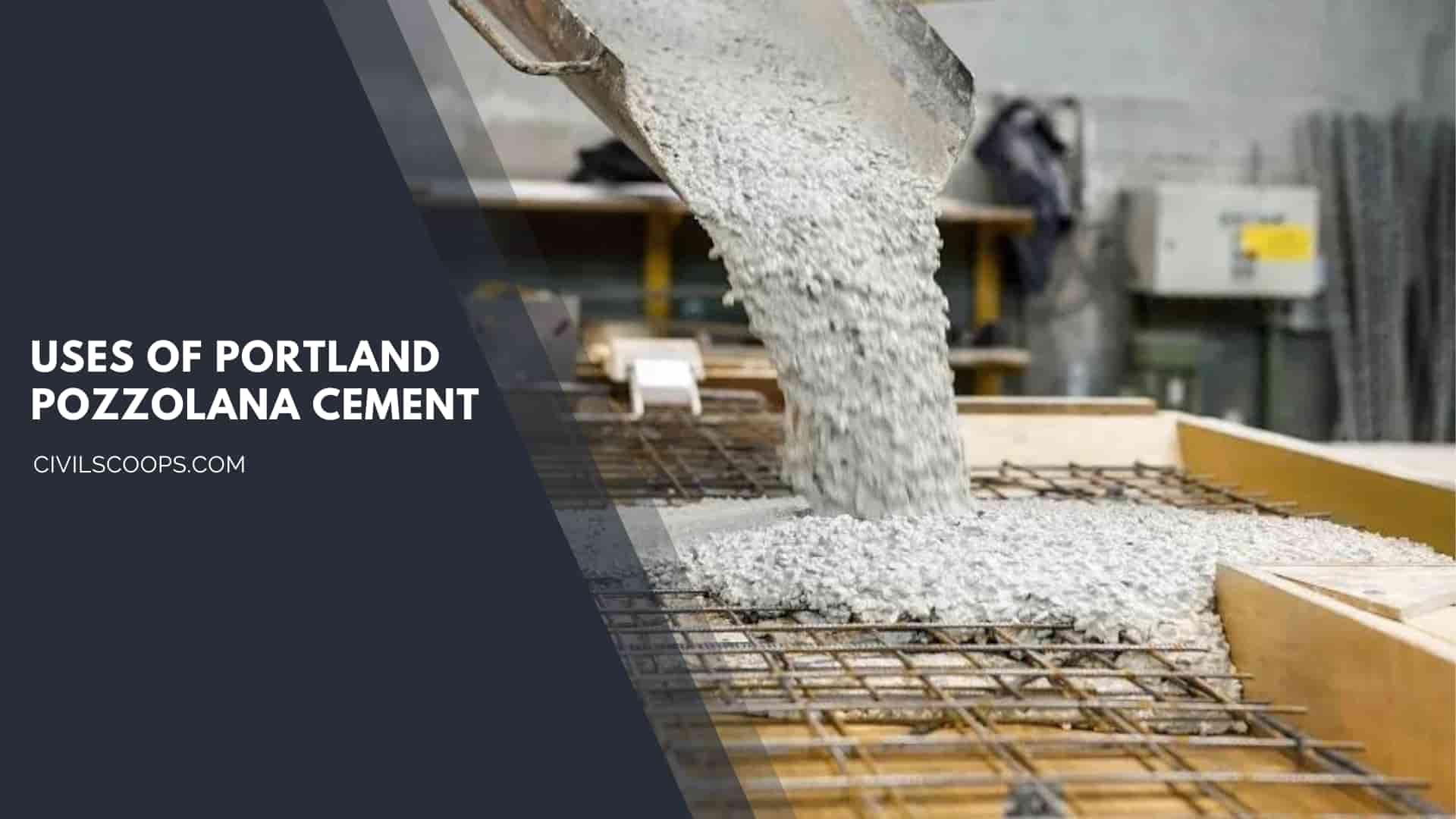
- Portland pozzolana cement is ideal for underground, water, or wet concrete works, in particular for projects that require impermeability, resistance to freshwater, and sulfate corrosion, including such hydraulic systems, marine structures, dam building, offshore construction, waste disposal, respectively.
- Owing to its weak resistance to frost, Portland pozzolana cement isn’t really ideal for low-temperature buildings and for the climate prone to freezing periods and alternating drying and wetting.
- Such as ordinary Portland cement, PPC cement too is suitable for general engineering including mass-concrete engineering. Owing to its wide dry shrinkage, it is not ideal for dry areas.
- CCP cement has low early strength, and therefore it is best suited for general engineering that would not need high early strength.
- PPC cement is essential as a strong surface finishes for decoration including artistic structures.
Advantages of Portland Pozzolana Cement
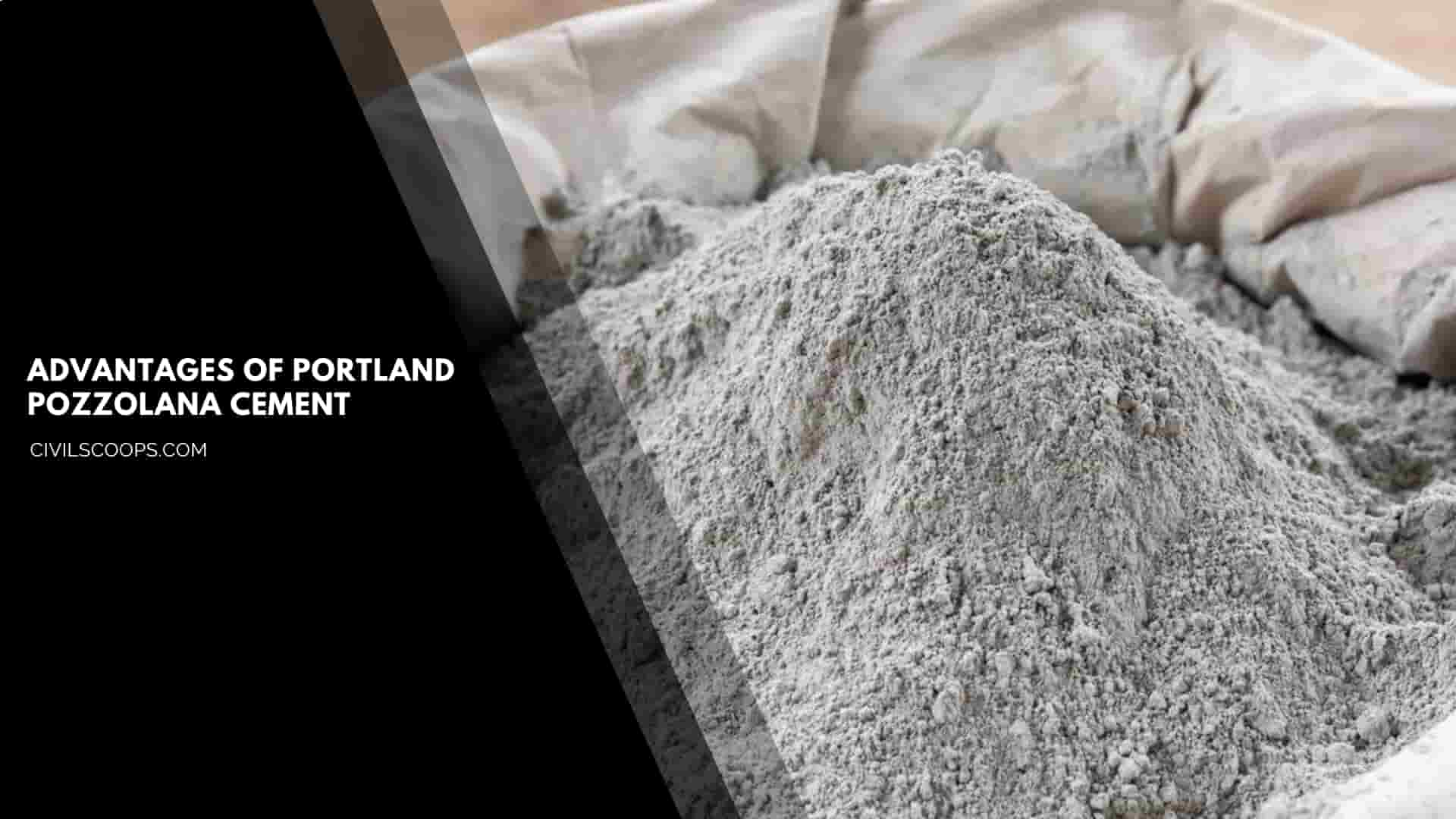
- It is an eco-friendly cement because the ingredients used in the manufacturing are manufactured from renewable recycled waste.
- It is very fine cement, therefore very good when used for plastering.
- Pozzolano comprises of silica material that makes it inexpensive and thus reduces the cost of cement making it economical to use.
- Pozzolana cement has a very high resistance to sulfate attacks and is thus used during hydraulic structures, coastal structures, building along the seashore, dam construction, etc.
- PPC used during pre-stressed and post-stressed concrete members.
- It eliminates carbon monoxide emissions from concrete, allowing it environmentally safe.
- Since the pozzolano materials are quite fine, the holes between the reinforcement and the aggregate can be filled, decreasing the shrinkage, minimizing the formation of honeycombs, and reducing leakage, which in turn increases the strength and toughness of the concrete.
Also Read: All About of Portland Cement Uses
Disadvantages of Portland Pozzolana Cement
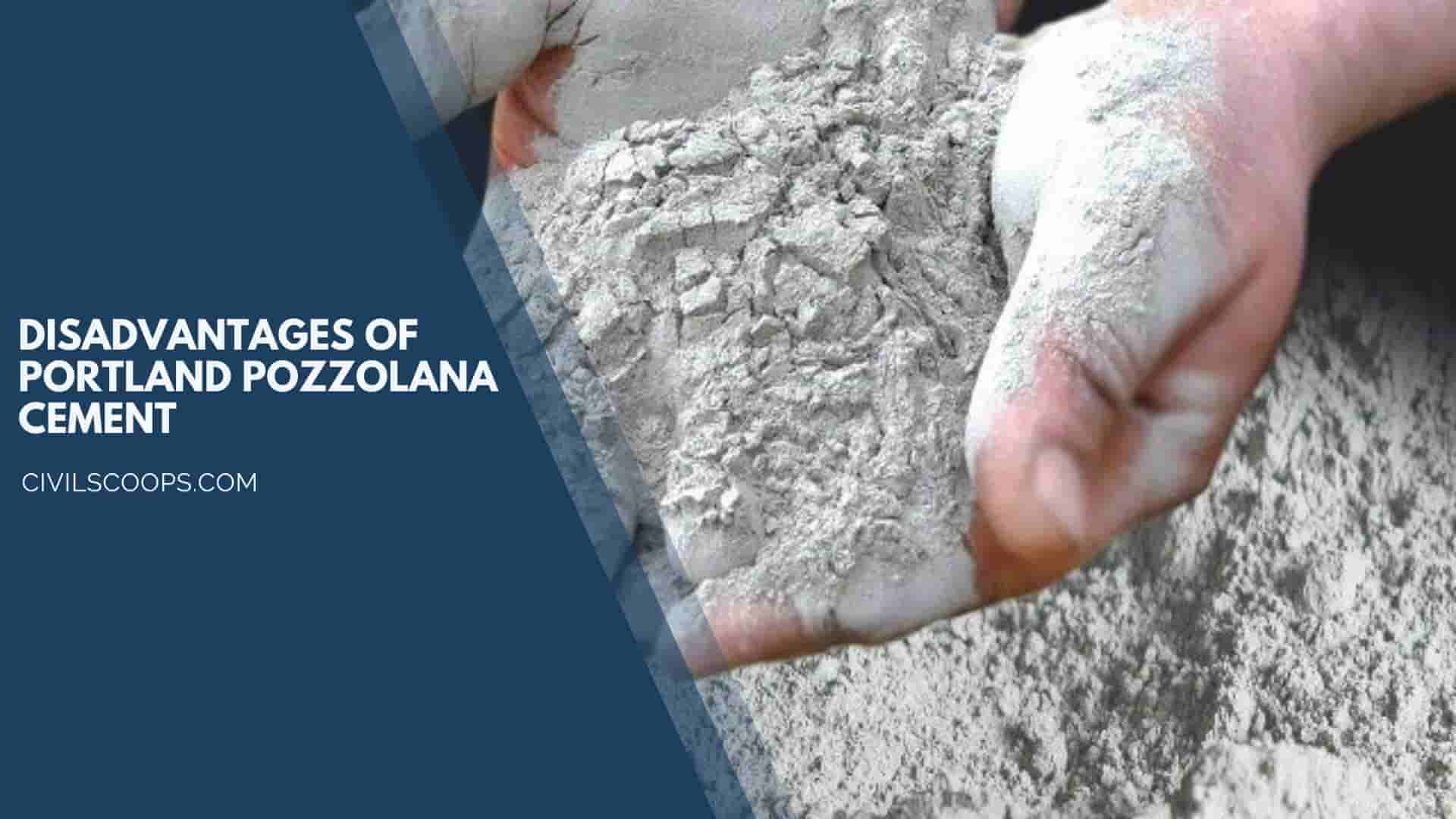
- The initial power acquired is smaller, which has an early effect on the deshuttering of supports.
- Since it includes more fine content, it is impossible to hand over concrete.
- As compared to the OPC setting time, the PPC setting time is lower.
- Reduction of alkalinity decreases susceptibility to corrosion of steel reinforcement.
- If the strength of this concrete steadily increases, the healing process is very important. Any flaw in this may cause issues with longevity.
[su_box title=”FAQ” style=”default” box_color=”#333333″ title_color=”#FFFFFF” radius=”3″ class=”” id=””]
What Is Ppc Cement?
PPC is a type of blended cement. It consists of 15-35% pozzolanic material, 4% gypsum and the rest is clinker. PPC as per BIS code is equivalent to that of 33 grade.
What Is the Difference Between Opc and Ppc Cement?
PPC concrete has higher strength than OPC concrete over a longer period of time. Generates more heat than PPC in hydration reaction which makes it less suitable for mass casting. It has a slow hydration process and thus generates less heat than OPC. OPC concrete is less durable in aggressive weather.
What Is Opc and Ppc Cement?
Generally, Ordinary Portland cement (OPC) is used in the factories, power plants and in large construction slabs. Portland pozzolana cement (PPC) is used for the construction of houses, schools, and residential building slabs. PPC is cheaper than ordinary Portland cement.
What Is Pozzolana Cement?
Pozzolanic cements are mixtures of portland cement and a pozzolanic material that may be either natural or artificial. The natural pozzolanas are mainly materials of volcanic origin but include some diatomaceous earths. Artificial materials include fly ash, burned clays, and shales.
What Does Ppc Cement Stand for?
PPC is a type of blended cement. It consists of 15-35% pozzolanic material, 4% gypsum and the rest is clinker. PPC as per BIS code is equivalent to that of 33 grade.
Use of Pozzolanic Materials
Pozzolanic Material
A pozzolan is a siliceous or siliceous and aluminous material that in itself possesses little or no cementitious value but will, in finely divided form and in the presence of moisture, chemically react with calcium hydroxide at ordinary temperatures to form compounds having cementitious properties.
Pozzolanic Materials Examples
Examples of pozzolanic materials are volcanic ash, pumice, opaline shales, burnt clay and fly ash. The silica in a pozzolana has to be amorphous, or glassy, to be reactive.
List of Pozzolanic Materials
Pozzolanic or Mineral Admixtures Used in Concrete
- Fly Ash.
- Silica Fume.
- Rice Husk Ash.
- Metakaolin.
- Surkhi (Calcined Clay Pozzolana)
- Ground Granulated Blast Furnace Slag (GGBS)
Types of Natural Pozzolans
The most common natural pozzolans used in concrete applications today include calcined clay, calcined shale and metakaolin. Other types of natural pozzolans that are used less in modern applications include volcanic ash, volcanic glass (pumicite and obsidian) and rice husk ash, among others.
Ppc Cement Full Form
PPC is a type of blended cement. It consists of 15-35% pozzolanic material, 4% gypsum and the rest is clinker.
Ppc Cement Is Code
The Portland Pozzolana Cement carries IS 1489 Part I mark. The White Portland Cement carries IS 8042 mark. Ordinary Portland Cement is commonly known as OPC and Portland Pozzolana cement is commonly known as PPC.
Best Ppc Cement in India
- Penna Cement PPC Grade. ₹ 340/ Bag Get Latest Price.
- Wonder Cement PPC and OPC. ₹ 345/ Bag Get Latest Price.
- Watch Video. Ppc Cement In All Over Gurgaon.
- Chettinad PPC Cement. ₹ 365/ Bag Get Latest Price.
- X.
- Ambuja Vijay Gold Cement.
- Searches related to PPC Cement.
- Ultratech Cement Ppc Cement.
Portland Pozzolana Cement Fly Ash Based
Portland Pozzolana Cement (BIS CERTIFICATION AS PER IS:1489 Part-I) is a fly-ash based blended cement. High-quality Portland cement clinker, gypsum and pozzolanic materials are thoroughly inter-ground or blended in certain proportions for producing PPC.
Uses of Pozzolana Cement
Uses of Portland Pozzolana Cement
- Used in hydraulic structures, marine structures, construction near the sea shore, dam construction etc.
- Used in pre-stressed and post-tensioned concrete members.
- Used in masonry mortars and plastering.
- As it gives better surface finish, it is used in decorative and art structures.
Density of Ppc Cement
The densities of OPC and PPC concretes were found to be 1665.82 kg/m3 and 1761.31 kg/m3, respectively.
[/su_box]
[su_note note_color=”#F2F2F2 ” text_color=”#333333″ radius=”3″ class=”” id=””]
Like this post? Share it with your friends!
Suggested Read –
- 20 Types of Construction Beam & Their Uses
- 14 Types of Plaster Finishes (List of Plaster Finishing)
- All About SBC of Soil | What Is SBC of Soil | Safe Bearing Capacity of Soil
- What Is Admixture | 26 Types of Admixtures | Advantages & Disadvantages of Admixture
- What Is Pneumatic Structures | Types of Pneumatic Structures | Advantages & Disadvantages of Pneumatic Structures | Uses of the Pneumatic Structures
[/su_note]
Originally posted 2023-03-22 13:37:55.
